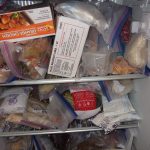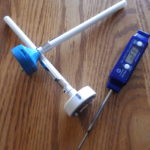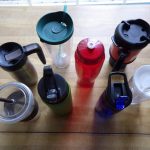 If you read this blog regularly, you know that we’re trying to reduce the amount of saturated fats that we eat at our house. This includes butter. https://news.nutritioneducationstore.com/the-butter-dish-is-empty/
If you read this blog regularly, you know that we’re trying to reduce the amount of saturated fats that we eat at our house. This includes butter. https://news.nutritioneducationstore.com/the-butter-dish-is-empty/
But, when teaching about food safety, I still get the question….should butter be kept in the refrigerator or is it safe on the counter? 
Obviously there are some foods that are more prone to making us sick than others. Foods like meat, poultry, eggs, fish, shellfish, dairy products, baked potatoes, garlic and oil mixtures, cooked plant food, raw sprouts, tofu and added more recently to this list are leafy greens, cut melons, cut tomatoes and mixtures of cut tomatoes fit into the “risky” group. These items should be kept in the refrigerator.
Common sense (and research) shows that other foods may be “less risky”. These are things like sugar, crackers, uncooked pasta and rice, uncut vegetables and fruits, chips and some baked goods.
What about butter? Since it’s a dairy food does it have to be kept in the fridge? 
Although it is did come from milk and could be considered a dairy product, butter has a high fat content and low water activity. These are not the right conditions for bacteria to grow. So, it’s not risky (at least food safety wise) to leave at room temperature.
Saying that, there is another problem: rancidity.
If butter is left out at room temperature for several days, the flavor can turn rancid. What is rancidity? This is a type of spoilage caused by a chemical reaction in the fat. This gives your butter that “off” smell or flavor. Keeping butter cold slows this spoilage process down.
If you’re like me and use butter very infrequently you may want to keep the butter in the freezer, but even freezing doesn’t stop quality deterioration completely. Butter will keep for six to nine months in the freezer, if it’s wrapped properly and held below zero degrees.
Also, in the freezer it’s out-of-site and out-of-mind. If it’s not setting on the counter next to the toaster I’m less likely to use it!
Cheryle Jones Syracuse, MS
Professor Emeritus, The Ohio State University
Compare:
| Spread | Serving | Calories | Fat (g) | Sat Fat (g) |
|---|---|---|---|---|
| Butter | 1 Tbsp | 100 | 12 | 7 |
| Light margarine | 1 Tbsp | 50 | 5 | .7 |
| Almond butter | 1 Tbsp | 100 | 9 | .7 |
| Apple sauce | 1 Tbsp | 20 | 0 | 0 |
| Peanut butter | 1 Tbsp | 94 | 8 | 1.5 |
- Butter, 1 tablespoon, 100 calories, 12 grams of fat, 7 grams of saturated fat
- Light margarine, 1 tablespoon, 50 calories, 5 grams of fat, .7 grams of saturated fat
- Almond butter, 1 tablespoon, 100 calories, 9 grams of fat, .7 grams of saturated fat
- Apple sauce, 1 tablespoon, 20 calories, 0 g fat
- Peanut butter, 1 tablespoon, 94 calories, 18 g of fat, 1.5 grams of saturated fat



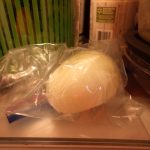

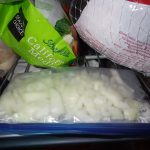
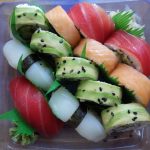


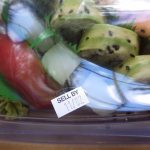
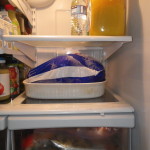 If you’ve followed my posts you know that I’ve worked for the Cooperative Extension System for almost 40 years. I remember when the phone rang-off-the-hook this time of year with various questions about thawing and cooking that Thanksgiving turkey. Calls to the office have lightened with telephone “help” hotlines and the internet, but the unique and potentially unsafe methods that people are trying to thaw a turkey haven’t changed—maybe they’re getting worse.
If you’ve followed my posts you know that I’ve worked for the Cooperative Extension System for almost 40 years. I remember when the phone rang-off-the-hook this time of year with various questions about thawing and cooking that Thanksgiving turkey. Calls to the office have lightened with telephone “help” hotlines and the internet, but the unique and potentially unsafe methods that people are trying to thaw a turkey haven’t changed—maybe they’re getting worse.

